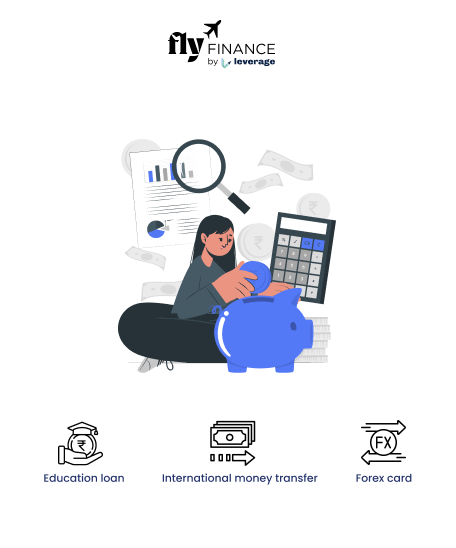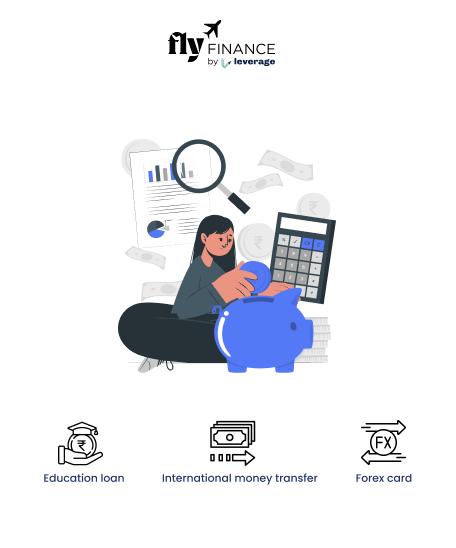Reasons for Education Loan Rejection: Education loans are a lifeline for students in India and abroad, helping them pursue quality education despite rising costs. However, many students face education loan rejection, often unaware of the reasons behind it.
This article explores the top reasons for education loan rejection and provides actionable tips to improve your chances of approval, whether you’re studying in India or overseas. Let’s explore!
Table of contents
- Top 10 Reasons for Education Loan Rejection
- 1. Low CIBIL Score
- 2. Poor Academic Performance
- 3. Unrecognized University or Institution
- 4. Unapproved Course Selection
- 5. Insufficient or Incomplete Documentation
- 6. Absence of Admission Letter
- 7. Chosen Country for Study
- 8. Unfulfilled Language Proficiency Requirements
- 9. Low Creditworthiness
- 10. Type of Loan (Secured vs. Unsecured)
- How to Avoid Education Loan Rejection
- FAQs on Education Loan Rejection
Top 10 Reasons for Education Loan Rejection
Understanding why education loans are rejected is crucial for improving your application. Below are the 10 most common reasons for education loan rejection, along with insights to address them.
1. Low CIBIL Score
A CIBIL score reflects your creditworthiness, and lenders typically require a score of 600 or higher for education loan to study abroad or in India. A low score, either for the student or co-applicant (e.g., parents), can be a major reason for education loan rejection. Here’s why it is:
Why It Happens: Missed payments, high debt, or no credit history can lower your score.
Solution: Check your CIBIL score before applying. If it is low, you should understand how to increase your CIBIL score for better education loans. Also, consider a co-applicant with a strong credit history or improve your score by clearing dues.
2. Poor Academic Performance
Lenders assess academic records to gauge a student’s commitment and employability potential. Poor grades or course discontinuations can be another reason for education loan rejection. Examples of poor performance:
- Scoring below 60% in board exams or degree programs.
- Failing subjects or losing a year.
- Inability to complete a course on time.
Solution: Highlight consistent academic improvement or strong entrance exam scores (e.g., JEE, NEET) to offset weaker grades.
Also Read: Check here some important tricks on how to remove derogatory marks from credit report
3. Unrecognized University or Institution
One common reason for education loan rejection is applying for loans to study at unrecognized or low-ranking institutions are often rejected, as lenders prioritize universities with strong placement records.
Why It Happens: Banks maintain a list of approved institutions, favoring globally recognized universities or those accredited by bodies like AICTE or UGC.
Solution: Research and apply to accredited institutions. Use resources like QS World University Rankings to identify reputable universities.
4. Unapproved Course Selection
Certain courses, especially those with low employability prospects, can be a reason for education loan rejection. Lenders typically prefer courses such as:
- STEM courses (Science, Technology, Engineering, Mathematics).
- Management Programs (e.g., MBA).
- Job-Oriented Courses (e.g., medicine, law).
- Why It Happens: Courses like MBBS or PhDs may face rejection from private lenders due to high costs or longer duration.
Solution: Choose courses aligned with market demand. Consult lenders about approved course lists before applying.
5. Insufficient or Incomplete Documentation
Among the various reasons for education loan rejection, incomplete or incorrect documentation is a leading cause of rejection, especially for secured education loans requiring collateral. Some common documentation Issues:
- Missing admission letters, income proofs, or collateral documents.
- Inconsistent details across documents.
Solution: Prepare a checklist of required documents (e.g., KYC, admission letter, fee structure) and verify them with the lender.
6. Absence of Admission Letter
Banks require a confirmed admission letter from the institution to process the loan. Without it, applications are rejected.
Solution: Secure admission and obtain a soft or hard copy of the offer letter before applying.
7. Chosen Country for Study
Lenders prefer countries with stable education systems and strong job prospects, such as:
Applications for countries like Ukraine, China, or Afghanistan may face rejection due to perceived risks.
Solution: Target universities in lender-approved countries. Check with banks for their country-specific policies.
8. Unfulfilled Language Proficiency Requirements
For international education, proof of language proficiency (e.g., IELTS or TOEFL for English-speaking countries) is mandatory. Unsatisfactory scores can lead to rejection.
Solution: Prepare thoroughly for language tests and aim for scores above the university’s minimum requirements (e.g., IELTS 6.5+).
9. Low Creditworthiness
Lenders evaluate the borrower’s (or co-applicant’s) financial stability, including income, repayment history, and employment prospects.
Why It Happens: Unstable income, high existing debt, or poor job prospects post-course completion.
Solution: Strengthen your application with a financially stable co-applicant or opt for secured loans.
10. Type of Loan (Secured vs. Unsecured)
Secured loans (backed by collateral) are easier to obtain than unsecured loans, especially for large amounts. unsecured loans to study abroad or in India require excellent credit, academics, and institutional reputation. Common Issues with Secured Loans:
- Using agricultural land or disputed property as collateral.
- Incomplete collateral documentation.
Solution: Opt for secured loans if eligible, and ensure collateral documents are complete and undisputed.
Also Read: Read this blog and understand the importance of a good credit score
How to Avoid Education Loan Rejection
To maximize your chances of approval of education loan, follow these actionable tips:
- Choose Reputable Institutions: Apply to accredited universities with strong placement records.
- Select High-Demand Courses: Opt for STEM, management, or job-oriented programs.
- Maintain Strong Academics: Aim for consistent grades and high entrance exam scores.
- Improve Your CIBIL Score: Clear dues and use a co-applicant with good credit if needed.
- Prepare Thorough Documentation: Double-check all documents before submission.
- Seek Expert Guidance: Platforms like Fly.Finance offer free counseling and connect you with multiple lenders to improve approval odds.
- Apply Early: Submit your application well before deadlines to address any issues.
Pro Tip: Fly.Finance, a leading education loan marketplace in India, has helped thousands of students secure loans by identifying red flags early and partnering with banks and NBFCs for faster approvals.
Education loan rejection can be disheartening, but understanding the reasons behind it empowers you to take corrective steps. By choosing reputable institutions, maintaining strong academics, and preparing thorough documentation, you can significantly improve your chances of approval. For personalized guidance, platforms like Fly.Finance offer expert support to navigate the education loan process seamlessly.
FAQs on Education Loan Rejection
Reason for education loan rejection may include low CIBIL scores, poor academic performance, unrecognized institutions, unapproved courses, incomplete documentation, or insufficient collateral.
Yes, an education loan request might be denied if the borrower does not meet the lender’s requirements. Academic, economic, or other factors may exist. Banks will not lend to you if the institute where you want to study does not have a solid placement record.
Being denied has no negative impact on your credit score. However, if you are refused, it has no further consequences beyond the initial inquiry. Consider lenders who offer prequalification if you’re unsure if you’ll qualify for a loan and want to avoid a hard inquiry.
No, a loan rejection itself does not impact your credit score, though the initial credit inquiry may cause a minor, temporary dip.
Choose accredited institutions, maintain strong academics, ensure complete documentation, and consider secured loans or expert platforms like Fly.Finance.
Education loan rejections often stem from:
Low CIBIL Score: A score below 600 for the applicant or co-applicant.
Poor Academic Performance: Low grades (below 60%), course discontinuation, or failure in subjects.
Unrecognized University: Applying to unaccredited or low-ranking institutions.
Unapproved Courses: Courses with low employability, like certain MBBS or PhD programs.
Incomplete Documentation: Missing admission letters, KYC, or collateral documents.
Chosen Country: Studying in high-risk countries (e.g., Ukraine, Afghanistan).
Language Proficiency: Unsatisfactory IELTS/TOEFL scores for international programs.
Low Creditworthiness: Unstable income or high existing debt of the borrower/co-applicant.
Solution: Choose accredited universities, maintain strong academics, and ensure complete documentation to boost approval chances.
You may face education loan rejection due to:
Financial Factors: Poor CIBIL score, high debt, or lack of a financially stable co-applicant.
Academic Issues: Inconsistent grades, failure to complete a course, or low entrance exam scores.
Institutional Risks: Applying to unrecognized universities or courses with poor job prospects.
Application Errors: Incomplete paperwork, missing admission letters, or disputed collateral (e.g., agricultural land).
Eligibility Gaps: Failing to meet lender criteria, such as language proficiency or country-specific requirements.
Solution: Research lender requirements, opt for secured loans if eligible, and seek expert guidance from platforms like Fly.Finance.
Most banks and NBFCs require a CIBIL score of 600 or higher for education loans, for both the student and co-applicant (e.g., parents). Some lenders, especially for unsecured loans, may demand a score of 700+ to ensure creditworthiness.
Why It Matters: A higher score reflects better repayment ability, reducing rejection risk.
Solution: Check your CIBIL score before applying. If low, improve it by clearing dues or use a co-applicant with a strong credit history.
This was all about the education loan rejection reasons and how you can avoid them. For more information, subscribe to Fly. Finance or connect with our experts for assistance.





























